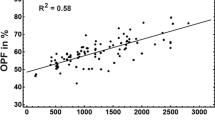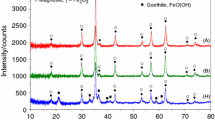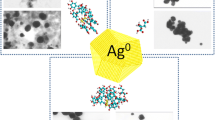Summary
Coagulation and reversal of charge effects of freshly prepared and heated solutions of hafnium tetrachloride have been studied as a function of the pH using aged silver halide sols and solsin statu nascendi. It was shown that the critical coagulation concentration and the critical stabilization concentration (due to charge reversal) increased with increasing pH. These observations have been related to the hydrolysis of the hafnium ion. At pH values above ∼4 essentially the entire amount of hafnium is present in the form of the neutral soluble, species Hf(OH)4. This accounts for the inability of the hafnium solutions to reverse the charge of the sols at higher pH values. The adsorption measurements carried out with the aid of the radioactive isotope181Hf showed that the neutral hydrolyzed species are strongly adsorbed on negatively charged silver iodide particles. The adsorbed amounts of hafnium on a AgI sol are considerably larger than in the case of charged hydrolyzed ions (such as hydrolyzed thorium ions) on a similar sol. This is explained by the ability of the neutral hafnium species, Hf(OH)4. to form a close-packed adsorbed layer. The results confirm previous findings that the enhanced adsorption of hydrolyzed ions is caused by the presence of the hydroxyl group, whereas the ionic charge plays a negligible role in this case.
Zusammenfassung
Die Koagulations- und Umladungserscheinungen von frisch dargestellten und durch Erwärmung gealterten Lösungen von Hafniumchlorid wurden an Silberhalogenid-Solen in der Abhängigkeit vom pH untersucht. Es wurde festgestellt, daß die kritische Koagulationskonzentration und die kritische Stabilisationskonzentration (die Umladungsgrenze) mit steigendem pH höher werden. Diese Beobachtungen wurden durch die Hydrolyse des Hafnium-Ions erklärt. Wenn pH>4 ist, bestcht nahezu die ganze Menge von Hafnium als neutrale, gelöste Hf(OH)4 Moleküle. Damit wird es erklärt, daß die Silberhalogenid-Teilchen bei höheren pH-Werten durch Hafniumsalze nicht umgeladen werden können. Die mittels des radioaktiven Isotopen181Hf durchgeführten Messungen zeigten, daß die neutralen Hf(OH)4 — Moleküle stark an den negativ geladenen Silberjodid-Teilchen adsorbiert sind. Die adsorbierte Menge per Mol von AgI ist beträchtlich größer als die Menge der geladenen, hydrolysierten Ionen (wie z. B. ThOH3+), die an dem gleichen Sol bestimmt wurde. Dieser Effekt ist leicht erklärt, da man mit den neutralen adsorbierten Molekülen eine fest gepackte Adsorptionsschicht bilden kann. Diese Resultate bestätigen die früheren Befindungen, daß die höhere Adsorptionsfähigkeit der hydrolysierten Ionen durch die Hydroxylgruppe verursacht wird, während die Ionenladung eine zu vernachlässigende Rolle spielt.
Similar content being viewed by others
References
Matijević. E., Reversal of Charge of Lyophobic Colloids, in: Principles and Applications of Water Chemistry, pp. 328–369 (New York 1967).
Abramson, M. B., M. J. Jaycock andR. H. Ottewill, J. Chem. Soc.1964, 5041.
Peshkova, V. M. andP'êng Ang, Zhur. Neorg. Khim.7, 2110, (1962); Engl. Transl. pp. 1091–1094.
Matijević, E., S. Kratohvil andL. J. Stryker, Discussions Faraday Soc.42, 187 (1966).
Stryker, L. J. andE. Matijević, Advances in Chem. Series79, 44 (1968).
Stryker, L. J. andE. Matijević, J. Colloid Interface Sci. 1969 (in press).
Ottewill, R. H. andM. C. Rastogi, Trans. Faraday Soc.56, 866 (1960).
Horne, R. W. andR. H. Ottewill, J. Phot. Sci.6, 39 (1958).
Matijević, E., G. E. Janauer andM. Kerker, J. Colloid Sci.19, 333 (1964).
Matijević, E. andM. Kerker. J. Phys. Chem.62, 1271 (1958).
Težak, B., E. Matijević andK. Schulz, J. Phys. Colloid Chem.55, 1557 (1951).
Mattson, S., J. Phys. Chem.32, 1532 (1928);37, 223 (1933).
Matijević, E., K. G. Mathai, R. H. Ottewill andM. Kerker, J. Phys. Chem.65, 826 (1961).
Peshkova, V. M. andP'eng Ang, Zhur. Neorg. Khim.6, 2082 (1961): Engl. Transl. pp. 1064–1066.
Herak, M. J. andM. Mirnik, Kolloid-Z.168, 139 (1960); ibid.179, 130 (1961).
Larsen, E. M. andP. Wang, J. Amer. Chem. Soc.76, 6223 (1954).
Ryabchikov, D. I., I. N. Marov, A. N. Ermakov andV. K. Belyaeva, J. Inorg. Nucl. Chem.26, 965 (1964).
Marov, I. N. andD. I. Ryabchikov, Zhur. Neorg. Khim.7, 1036 (1962); Engl. Transl. pp. 1064–1066.
Larsen, E. M. andA. M. Gammill, J. Amer. Chem. Soc.72, 3615 (1950).
Muha, G. M. andP. A. Vaughan, J. Chem. Phys.33, 194 (1960).
Copley, D. B. andS. Y. Tyree, Jr. (to be published).
Tyree, S. Y. Jr., Equilibrium Concepts in Natural Water Systems, Advances in Chem. Series67, 183 (1967).
Lebedeva. E. N., S. S. Korovin andA. M. Rozen, Zhur. Neorg. Khim.9, 1744 (1964): Engl. transl. pp. 944–951.
Roy. A. P., J. Chim. Phys.65, 475 (1908).
Težak, B., E. Matijević andK. Schulz, J. Amer. Chem. Soc.73, 1602, 1605 (1951).
Težak, B., E. Matijević andK. Schulz, J. Phys. Chem.59, 769 (1955).
Matijević. E., M. B. Abramson, K. F. Schulz andM. Kerker, J. Phys. Chem.64, 1157 (1960).
Wear, J. O. andK. Matijević, J. Phys. Chem.70, 3825 (1966).
Matijević, E., K. G. Mathai amdM. Kerker, J. Phys. Chem.66, 1799 (1962).
Černicki, B. andB. Težak, Croat. Chem. Acta28, 13 (1956);M. Biffl andB. Težak, Croat. Chem. Acta30, 9 (1958).
Matijević, E. andL. H. Allen, Envir. Sci. Technol.3, 264 (1969).
Matijević, E. andL. J. Stryker, J. Colloid Interface Sci.22, 68 (1966).
Matijević, E., M. B. Abramson, R. H. Ottewill, K. F. Schulz andM. Kerker, J. Phys. Chem.65, 1724 (1961).
Author information
Authors and Affiliations
Additional information
Supported by the U.S. Army Research Office (Durham), Grant No. DA-ARO (D)-31-124-G 656.
Part of a PhD Thesis byL. J. Stryker, supported by a NASA Traineeship.
Rights and permissions
About this article
Cite this article
Stryker, L.J., Matijević, E. Interactions of silver halide sols with hydrolyzed hafnium species. Kolloid-Z.u.Z.Polymere 233, 912–921 (1969). https://doi.org/10.1007/BF01508015
Received:
Issue Date:
DOI: https://doi.org/10.1007/BF01508015




